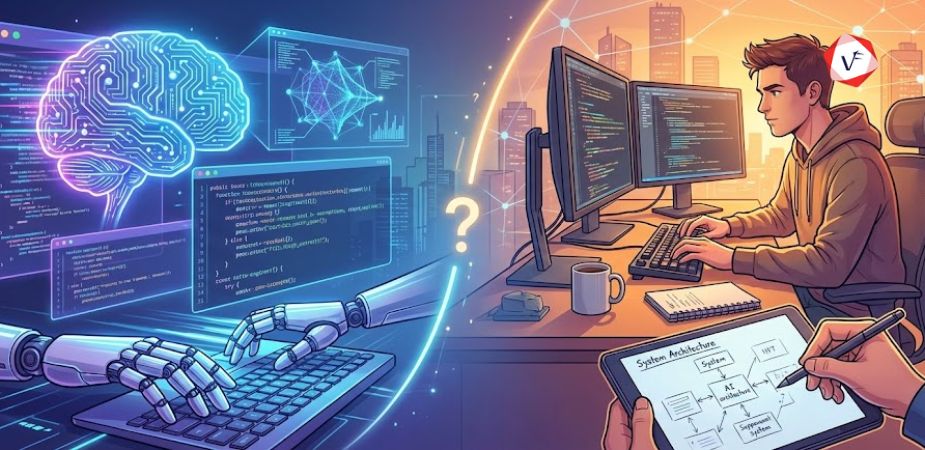Top React JS Frameworks to Use in 2025 — In-Depth Guide
In this comprehensive guide, we cover the best React JS frameworks for 2025 — their features, pros and cons, real use cases, and how to pick the right one for your project. Plus, we share trends to watch and SEO/AEO strategies to boost traffic.
Why Use React Frameworks in 2025?
React by itself is a powerful library, but adding a framework brings full solutions: routing, server-side rendering, data loading strategies, build optimization, and more. In 2025, with users expecting fast load times and AI engines consuming content, picking the right framework is more critical than ever.
Frameworks help you:
-
- Improve SEO via server-rendered or prerendered pages
-
- Manage data flows more robustly (data fetching, caching, mutations)
-
- Optimize performance — splitting JS, lazy loading, minimizing payloads
-
- Provide consistent developer experience and scalability
- Support modern features like edge computing, incremental builds, and serverless APIs
Popular React Frameworks & Libraries in 2025
Next.js
Overview: Next.js is currently a top choice for React-based web apps. It supports hybrid rendering — Static Site Generation (SSG), Server-Side Rendering (SSR), and Incremental Static Regeneration (ISR). It also provides API routes, built-in image optimization, and edge functions.
Use cases: Enterprise websites, e-commerce, SaaS dashboards, content platforms.
Pros: SEO-friendly, flexible rendering strategy, strong community, Vercel integration, file-based routing, automatic code splitting.
Cons: More complexity when mixing SSR and client-side logic; server code must run in Node / edge environment; sometimes opinionated directory structures.
Remix
Overview: Remix is a framework focused on performance, data loading, and seamless UX. It uses nested routes for granular control and real-time UI transitions. It emphasizes progressive enhancement, where the page works even without JS.
Use cases: Apps that require fast UX, complex nested data fetching, and control over caching strategies.
Pros: Fine-grained control, predictable loading states, solid routing model, less wasted requests.
Cons: Learning curve for nested loaders and actions; smaller plugin ecosystem than Next.js.
Gatsby
Overview: Gatsby is a static site generator (SSG) for React. It shines for content-rich websites: blogs, marketing sites, documentation. Its plugin ecosystem enables pulling data from many sources (CMS, Markdown, APIs).
Use cases: Blogs, documentation, content marketing websites.
Pros: Fast static output, strong plugin ecosystem, image and asset optimization, built-in SEO features.
Cons: Build times can grow with large sites; dynamic behavior must be hydrated; more challenging for highly dynamic apps.
RedwoodJS
Overview: RedwoodJS is a full-stack React framework that bundles frontend, backend (GraphQL API), database layer (Prisma), and conventions in one stack. It’s ideal for rapidly building MVPs or full apps with React as the UI.
Use cases: Startups or teams that want a unified stack and fast iteration cycles.
Pros: End-to-end conventions, built-in tooling, developer-friendly abstractions, good for small to medium apps.
Cons: Less flexible if you already have separate backend infrastructure or complex existing systems.
React Native
Overview: React Native enables building native mobile apps (iOS, Android) using React. In 2025, improvements in performance, bridging modules, and architecture changes make it even more compelling.
Use cases: Cross-platform mobile apps with shared business logic between web and mobile.
Pros: Single JS codebase, large community, reusable modules, native-like performance for many use cases.
Cons: Platform-specific challenges, native module complexity, sometimes need native coding for advanced features.
Vite + React
Overview: Vite is a modern build tool that gives lightning-fast dev experience. Though not a full “framework,” pairing Vite with React and routing libraries yields a lean, fast, developer-centric stack.
Use cases: SPAs, dashboards, prototypes, small-to-mid scale apps.
Pros: Extremely fast HMR, minimal config, good TypeScript integration.
Cons: You must choose routing, state, and data layers yourself; less built-in support.
Astro with React
Overview: Astro uses an “islands” architecture: you can ship minimal JavaScript by default, and only hydrate parts of the page that need interactivity. You can include React components along with others.
Use cases: Content-heavy sites, blogs, marketing pages where JS payload minimization is crucial.
Pros: Very low JS by default, high performance, flexible integration of multiple frameworks.
Cons: Less suited for very dynamic applications requiring full client-side logic everywhere.
Blitz.js
Overview: Blitz.js is a full-stack React framework inspired by Ruby on Rails. It aims to give you everything out-of-the-box: authentication, database, backend, API layers — with minimal config.
Use cases: MVPs, startups, or developers wanting conventions over configuration.
Pros: Batteries-included, simplified data fetching (queries & mutations), full-stack experience.
Cons: Opinionated; may hide complexity; less mature ecosystem compared to Next.js.
UI Libraries & Tooling (MUI, Mantine, Tailwind, Chakra, Ant Design)
Frameworks are one part; the UI libraries and tooling you choose also matter deeply. Some popular picks in 2025:
-
- Material UI (MUI) — widely used, strong component ecosystem
-
- Mantine — modern, flexible, good for customizing
-
- Chakra UI — accessible defaults, theming support
-
- Ant Design — enterprise-grade components, form-heavy UI
- Tailwind CSS (with Headless UI / Radix) — utility-first styling + unstyled components
Choosing a good UI library ensures consistency, accessibility, and developer productivity.
Trends & Innovations to Watch in 2025
-
- Edge Rendering & Edge Functions: Running code close to users reduces latency and improves performance.
-
- Incremental / On-Demand Static Generation: Generate pages only when needed to manage large sites.
-
- Server Components: Using React Server Components to offload UI logic to the server.
-
- Zero JS by Default: Default to minimal client JS, hydrate only where required.
-
- Better Data Layer Abstractions: Tools like tRPC, React Query, SWR, or GraphQL layers evolving to more transparent data handling.
-
- AI-Assisted Development: Code generation, auto documentations, predictive linting, live debugging via AI tools.
Use-Case Guides & Best Practices
Building a Blog or Content Site
Choose Gatsby, Astro, or Next.js with SSG mode. Use incremental builds, lazy loading images, and head metadata. Integrate with headless CMS like Strapi, Contentful, and Sanity.
Building a SaaS Dashboard / Admin Panel
Next.js (SSR / ISR) is often a good fit. Use UI libraries (e.g., MUI, Chakra) and data fetching libraries (React Query, SWR) to build real-time UIs. Pay attention to permissions, lazy load heavy modules, and code-split routes.
Full-Stack Apps with API + UI</
Consider RedwoodJS or Blitz.js. They tie together both front-end and backend. You might also use Next.js API routes or integrate with serverless functions (AWS Lambda, Vercel functions).
Mobile + Web Shared Logic
Use React Native for mobile and share business logic or API modules across web and mobile. For UI differences, maintain separate component layers.
How to Decide the Best Framework for Your Project
- Define your priorities: SEO? static pages? real-time? mobile companion?
- Project scale: small site vs large enterprise vs multi-product.
- Team expertise: what your team already knows (SSR, GraphQL, serverless, etc.)
- Ecosystem & community: is there solid plugin support or third-party integrations?
- Performance & costs: server costs, build time, hosting constraints.
SEO, AEO, GEO & Voice Optimization Tips
SEO & AEO:
– Use meaningful headings (H1, H2, H3) with keywords like “best React frameworks 2025.”
– Embed FAQs (question headings with short answers) so answer engines can pick them.
– Use internal links to other relevant articles and anchor texts like “React performance tips,” “server-side rendering guide.”
– Add schema / structured data (Article, FAQ) to help generative engines understand your content.
GEO (Generative Engine Optimization):
– Use conversational tone; craft natural question/answer sentences so AI summarizers can copy snippets.
– Include variation in phrasing (e.g. “Which React framework is best?” “Top frameworks in 2025”) so generative engines can match multiple queries.
– Use clear, self-contained subheading answers (so a snippet can be taken from any section).
– Use simpler sentences and avoid overly deep, dense paragraphs.
Voice Optimization:
– Keep answers short (40–80 words) under question headings.
– Use question-style headings like “What is Next.js best used for?” or “How to choose a framework?”
– Use natural language, not just keywords — generative assistants prefer conversation style.
Frequently Asked Questions
Which React framework is best for SEO in 2025?
The best framework for SEO is one that supports server-rendering or static generation. In 2025, Next.js often leads because it offers hybrid rendering (SSR + ISR). Gatsby and Remix are also good options, depending on your use case.
Can I migrate from Gatsby to Next.js?
Yes, but migration involves rewriting data loading logic and adjusting routing. Many teams migrate to Next.js for more flexibility or hybrid rendering needs.
Does React Native work with web React code?
You can share business logic and some modules, but UI components are different. Use shared modules and keep separate UI layers for mobile and web.
When is Astro a better choice than Next.js?
Choose Astro when you want to minimize client-side JavaScript and build mostly static, high-performance content sites that still require some interactivity.
Is RedwoodJS good for production apps?
Yes. RedwoodJS supports production usage with conventions, auto code generation, and integration with popular services. But it’s best when you control both front and back ends.
Conclusion
In 2025, there is no “one-size-fits-all” framework. The right choice depends on your project goals:
– Use Next.js or Remix when SSR, SEO, and dynamic behavior matter.
– Use Gatsby or Astro for content-first sites with minimal JS.
– Use RedwoodJS or Blitz for full-stack convenience.
– Use React Native when mobile apps are needed.
Pair your choice with good UI libraries, solid architecture, performance best practices, and SEO / generative engine optimization strategies. That way, your site is fast, discoverable, voice/AI-friendly, and ready to scale.





